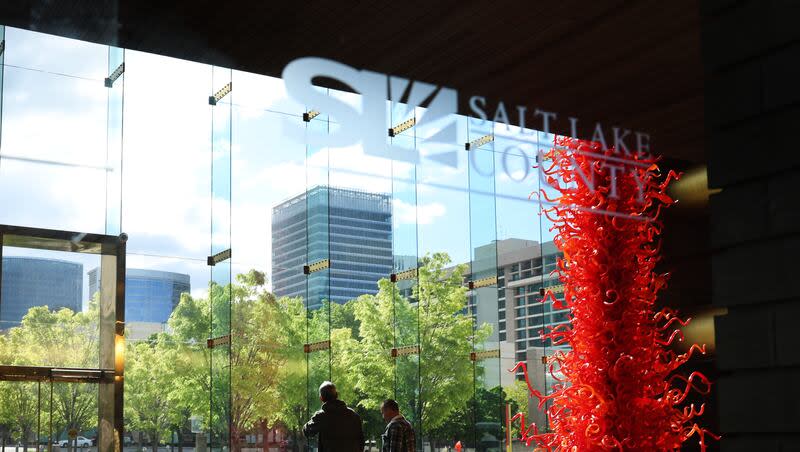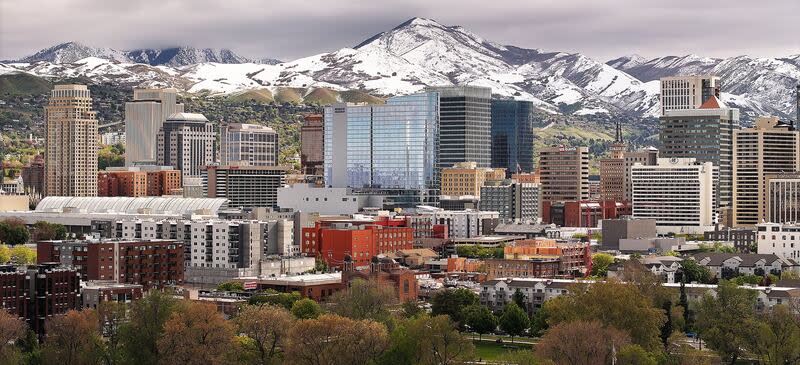SLC residents weigh in on downtown revitalization, Abravanel Hall future

Downtown Salt Lake City is on the verge of a massive transformation. And although specific plans have yet to emerge publicly, Utahns on Tuesday had their first opportunity to express their opinions before the two government bodies that will play an integral role in the capital city’s future.
Both the Salt Lake City Council and the Salt Lake County Council heard from residents in two separate meetings focused on a proposed sales tax increase to help fund the project, including renovating the Delta Center, and what might be ahead for Abravanel Hall, the Utah Museum of Contemporary Art and Japantown.
Smith Entertainment Group is proposing to invest $3 billion to redevelop the area around the Delta Center as a sports, entertainment, culture and convention district including retail, restaurants, hospitality, multifamily housing, and other entertainment and cultural uses and parking. It includes remodeling the arena over several offseasons to accommodate both the NBA’s Utah Jazz and Utah’s new NHL team. Jazz owners Ryan and Ashley Smith bought the Arizona Coyotes and moved the team to Salt Lake City last month.
“This is about an opportunity to reimagine and revitalize our downtown community and create an incredible urban core. None of that happens without all four of these elements coming together,” Mike Maughan, a principal in SEG, told the City Council.
Maughan said the Jazz, the hockey team and other events at the Delta Center are expected to bring $600 million in economic impact to Salt Lake City every year, citing a 2022 GSBS Consulting report and 2024 DA Davidson analysis under peer review by the Kem C. Gardner Policy Institute.
SEG wants to lease two additional blocks east of the arena from Salt Lake County, which includes the Salt Palace Convention Center and Abravanel Hall. In documents filed with the city, SEG said the project could include substantial redevelopment, urban renewal and reconstruction, including the rerouting, permanent closure and/or bridging of some surrounding streets. The company also wants to revise zoning ordinances to eliminate maximum height limitations in the project zone and identify arenas, heliports and parking as permitted uses.
The future of the 45-year-old Abravanel Hall has particularly come into question in the past few weeks. The proposed downtown district could also impact a historically and culturally significant street known as Japantown.
Proposed sales tax increase
Earlier this year, the Utah Legislature, with Salt Lake City and Salt Lake County support, passed legislation allowing the creation of a downtown revitalization zone. Under the law, the city could raise its current 7.75% sales tax rate one-half of a percent — pushing it to 8.25% over no more than 30 years to help fund construction or remodeling of a sports arena. The citywide tax increase could generate in the neighborhood of $1 billion.
Dozens of residents, members of the arts, tourism and business communities and others expressed a variety of views on the proposal. Some opposed raising the sales tax to subsidize the project, arguing it would only benefit billionaires. Others told the council it would build on and encourage economic investment not only in Salt Lake City but in the region. Those in the hospitality and tourism industries favor creating the district to boost convention business. Some welcomed a new vision for downtown.
“Is the Smith Entertainment Group project really your top and only priority for the expenditure of precious additional sales tax revenues in our city?” former Salt Lake City Mayor Rocky Anderson asked the council. If the tax increase were to raise $1 billion, residents would prioritize improving air quality, eliminating homelessness, expanding open space, providing affordable housing and saving the Great Salt Lake over subsidizing a “billionaire for his hockey arena and so-called revitalization zone,” he said.

Several residents noted the lack of any specific plans and said that the process is moving too quickly.
Maughan acknowledged it is moving fast.
“But a fast process does not mean that it is not a deliberate one,” he said. “This tax would be the first step. But to be very clear, this process will be in-depth, it will be deliberate and it will be iterative.”
The City Council has targeted July 2 for making a final decision on creation of the downtown district and raising the sales tax.
Future of Abravanel Hall
Many people sporting “Save Abravanel Hall!” and “UMOCA Matters” urged city leaders to not tear down the home of the Utah Symphony, including a woman who broke out in operatic song and Carolyn Abravanel, whose late husband’s name is on the building.
Named after Maurice Abravanel, who worked as the Utah Symphony conductor for 30 years, the hall was created out of the 1975 Bicentennial Bond approved by voters. It was built on land donated by The Church of Jesus Christ of Latter-day Saints and opened in 1979. Improvements to the inside and outside of the building have been made over the years, the last time in 2017.
The decision over Abravanel Hall rests with Salt Lake County, which owns and operates the venue, not Salt Lake City. But residents told City Council members that it doesn’t absolve them of playing a role in its future.
“We will not stand for you or the county messing with Abravanel Hall, including the plaza out in front. I hope you’ve gotten that message loud and clear. If there is any threat of razing or significantly altering Abravanel Hall, then just say no to the tax increase. You do have control over what happens to Abravanel Hall,” Anderson told the council, drawing applause from the crowd.
Maughan told the City Council that SEG will support whatever the county chooses to do. “We feel strongly that a symphony hall, that the arts, stay on site and that we continue to have it as an important piece of what we’re doing with the sports, entertainment, culture and community district,” he said.
Earlier Tuesday, a group of architects, musicians, opera members, county facilities and arts and culture members, and the Salt Lake County mayor’s office presented a renovation plan to the Salt Lake County Council that showed the venue is outdated and needs significant upgrades. It noted the outdoor plaza is underused despite its prominent downtown location and the hall lacks connectivity to the Salt Palace and Utah Museum of Contemporary Art as well as other attractions. The master plan was developed last year before the NHL arrived and talk of downtown revitalization became a hot topic.
The plan estimates the cost of renovating the building at between $199 and $219 million, including performance space, front-of-house upgrades and additions, back-of-house improvements, event space additions and plaza upgrades. Retrofitting the hall for earthquake mitigation would add another 10%.
Salt Lake County Mayor Jenny Wilson has said she wants to keep Abravanel Hall “in its present form” rather than be torn down and rebuilt. She reiterated that Tuesday and said county leaders have “months and months” to explore options for the building as well as for Japantown.
Residents told the Salt Lake County Council in a meeting Tuesday that they oppose tearing down the home of the Utah Symphony, which they said would put the orchestra’s future at risk and dishearten young musicians. The Utah Symphony is one of 17 full-time symphonies in the country.
“It is a treasure and we would hate to lose it,” Angel Vice, a member of the Millcreek Arts Council, said of Abravanel Hall.
Salt Lake County, which has only $8 million in its deferred maintenance budget for Abravanel Hall, doesn’t have the funds to renovate the building. But Wilson said there may be “some money on the table” as part of the broader entertainment district plan. Wilson also said it would cost roughly the same to update the venue as it would to build new.
County Council member Dave Alvord called Abravanel Hall a “cultural icon” and a “jewel” in the city. “How we preserve it is not totally clear today,” he said.
Reviving Japantown
The proposed downtown district could also impact a historically and culturally significant street known as Japantown. Construction of the Salt Palace in 1969 displaced the Japanese community that once stretched across 100 South, leaving only a small section of the street west of what is now the Salt Palace Convention Center that claims the honorary name Japantown Street. The Salt Lake Buddhist Temple and the Japanese Church of Christ are the last remaining landmarks.
Marisa Eng, who said she grew up attending the Salt Lake Buddhist Temple, said the revitalization effort is an opportunity for the city, county and SEG to include the Japanese American community as key stakeholders in downtown to “break down walls and correct past injustices.” She also said she’s concerned with the speed of the project and that it must be done thoughtfully.
City and county leaders have expressed desire to incorporate Japantown into the revitalization project.
Maughan said Japantown is currently greeted by loading docks at the back of the Salt Palace. He said SEG has “every intention” to replace the loading docks with street-facing spaces to enliven the area.
The Crossroads Urban Center sent a letter to the City Council last week saying it’s “imperative” that any new housing around the Delta Center include affordable units for low-income residents. The proposed project can either be a model for including mixed-income housing in a mixed-use development or a lesson in why housing affordability concerns get ignored, the center posted on X.
“If all taxpayers, including struggling renters, will be helping to finance the creation of this district then it is only fair to demand that some of the housing in it be affordable,” according to the letter. “It is long past time to quit giving our city away to developers without expecting a tangible benefit for our community, especially low- and moderate-income residents struggling to get by each month.”
SEG has proposed it receive the additional tax revenue for the full 30 years. It would subtract 1% of the taxes collected as administrative fee to the city and an undetermined amount as agreed upon with Salt Lake County for its renovation of the Salt Lake Palace Convention Center. SEG also says the project might require tax increment financing and creation of a public infrastructure district.
The Delta Center is currently part of a property tax reimbursement agreement with the Salt Lake City Redevelopment Agency that started in 2019 and runs through 2040. To date, SEG has received about $3.5 million of the maximum $22.7 million over that time. SEG also leases the block on which the Delta Center sits from the RDA and is proposing a new 99-year lease on the existing terms.

